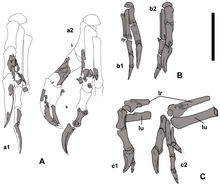Nemegtomaia
| Nemegtomaia | ||||||||||||
|---|---|---|---|---|---|---|---|---|---|---|---|---|

Head reconstruction of Nemegtomaia barsboldi |
||||||||||||
| Temporal occurrence | ||||||||||||
| Upper Cretaceous ( Maastrichtian ) | ||||||||||||
| 72 to 66 million years | ||||||||||||
| Locations | ||||||||||||
| Systematics | ||||||||||||
|
||||||||||||
| Scientific name | ||||||||||||
| Nemegtomaia | ||||||||||||
| Lü et al. , 2005 | ||||||||||||
| Art | ||||||||||||
|
||||||||||||
Nemegtomaia is a theropod dinosaur from the group of oviraptorosauria who in the Upper Cretaceous of Mongolia lived.
The only known species ( type species ) of this genus , Nemegtomaia barsboldi , was first described in 2004 . Nemegtomaia was a derived (advanced) oviraptorosaur that, like related genera, showed a short and deep skull with toothless jaws shaped into a beak. Presumably it was herbivorous or omnivorous . Within the Oviraptorosauria, Nemegtomaia is counted to the Oviraptoridae . Phylogenetic studies initially suggested that Nemegtomaia was more closely related to Citipati than to other known oviraptorids; in 2012, however, the genus was added to the Ingeniinae , close to Heyuannia .
Find and naming
The first find is an incomplete skeleton with an almost complete skull ( holotype , catalog number MPC-D 100/2112). These fossils were discovered in the summer of 1996 by the team of the Highland International Dinosaur Project under the Japanese paleontologist Yoshitsugu Kobayashi in the Nemegt site in southwestern Mongolia. Stratigraphically , this site belongs to the Nemegt formation and was deposited in the middle Maastrichtian , about 68 million years ago. Lü et al. described the find in 2002 initially as Ingenia sp. Because of at least five autapomorphies (unique features) on the skull, however, the researchers set up a separate genus and species for the find in 2004, which they named Nemegtia barsboldi . Later it turned out that the genus name Nemegtia had already been given to a fossil mussel crab (Ostracoda) from the same rock formation, which is why the genus was renamed Nemegtomaia in 2005 . The skeleton is now in the Paleontological Center of the Mongolian Academy of Sciences in the Mongolian capital Ulaanbaatar .
In addition to the almost complete skull, among others, almost all cervical vertebrae in the anatomical composite are preserved, some vertebrae, the almost complete sacrum (sacrum), pelvis (both ilium (Ilia), the proximal ends of pubic and ischial (pubis and ischium)) Parts of the humerus (upper arm bone), the spoke (radius) and the proximal end of the femur ( thigh bone ).
The original genus name Nemegtia refers to the Nemegt basin, the rock unit from which the fossils come. The newly added ending -maia is ancient Greek for "mother", the new valid generic name Nemegtomaia therefore means something like "mother from Nemegt". The epithet barsboldi honors the paleontologist Rinchen Barsbold , one of the directors of the Highland International Dinosaur Project .
In 2007 two more specimens were found from the "Dinosaurs of the Gobi" expedition, which were described by the Italian paleontologist Federico Fanti and colleagues in 2013. The first specimen (MPC-D 107/15, called "Mary") comes from the Baruungoyot formation and consists of a nest with a presumed parent animal on it, which goes well with the (previously assigned) current name ending '-maia' (mother) fits. After Oviraptor , Citipati , and Machairasaurus, Nemegtomaia is the fourth Oviraptorosaur to be found breeding on a nest.
The third specimen (MPC-D 107/16) was found by the American paleontologist Nicholas R. Longrich in the Nemegt formation.
features
Like some other Oviraptoriden Nemegtomaia showed a skull crest, which was formed from the nasal bone and intermaxillary bone (premaxilla). The front edge of this ridge was almost vertical, while the highest point was in a round arc. As with other oviraptorids, the intermaxillary bone, the upper jawbone (maxillary) and the ploughshare (vomer) formed a hard palate . The antorbital cavity in front of the eyes consisted of two cranial windows: a large antorbital window in the back of the cavity and a small maxillary window in the front. Between the frontal bone and the tear bone, there is a triangular bone on the left side of the skull, which is probably a prefrontal. This bone is not known from any other oviraptorosaur.
Eight sacral vertebrae (sacral vertebrae) could be identified on the residual skeleton (postcranium) that follows the skull - as many as in other oviraptorids such as Heyuannia , but significantly more than in most other non-avian theropods. Almost all cervical vertebrae have been preserved in their natural, anatomical association; Nemegtomaia showed a total of 13 cervical vertebrae.
Systematics
Position of Nemegtomaia among the Oviraptorids, according to Fanti et al. , 2012:
| Oviraptoridae |
|
|||||||||||||||||||||||||||||||||||||||||||||
|
|
literature
Unless otherwise stated, all information comes from the following work:
- Junchang Lü, Yukimitsu Tomida, Yoichi Azuma, Zhiming Dong, Yuong-Nam Lee: New oviraptorid dinosaur (Dinosauria: Oviraptorosauria) from the Nemegt Formation of southwestern Mongolia. In: Bulletin of the National Museum of Nature and Science. Tokyo. Series C: Geology & Paleontology. Vol. 30, 2004, ISSN 0385-244X , pp. 95-130, digital version (PDF; 3.06 MB) .
Individual evidence
- ↑ Federico Fanti, Philip J. Currie , Demchig Badamgarav: New Specimens of Nemegtomaia from the Baruungoyot and Nemegt Formations (Late Cretaceous) of Mongolia. In: PLoS ONE . Vol. 7, No. 2, 2012, e31330, doi : 10.1371 / journal.pone.0031330 , online
- ↑ a b c d F. Fanti, PJ Currie, D. Badamgarav, C. Lalueza-Fox: New specimens of Nemegtomaia from the Baruungoyot and Nemegt Formations (Late Cretaceous) of Mongolia . In: PLoS ONE . 7, No. 2, 2012, p. E31330. bibcode : 2012PLoSO ... 731330F . doi : 10.1371 / journal.pone.0031330 . PMID 22347465 . PMC 3275628 (free full text). Retrieved January 8, 2018.
- ↑ In older publications the type copy is referred to as GIN or PC 100/2112 (also GIN or PC 1001 2112).
- ^ Lü, J., Dong, Z., Azuma, Y., Barsbold, R. & Tomida, Y. (2002). "Oviraptorosaurs compared to birds." In Zhou, Z. & Zhang, F. (eds). Proceedings of the 5th Symposium of the Society of Avian Paleontology and Evolution. Beijing: Science Press. pp. 175-189.
- ↑ Victoria M. Arbor: Gobi Desert Diaries: Nemegtomaia Edition . 2012. Retrieved January 8, 2018.





